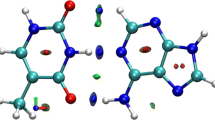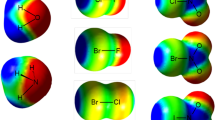Abstract
Very recently [J. Phys. Chem. A 2018, 122 (11), 3087–3095], we proposed to employ the Pauli energy to identify and determine strong covalent interactions (SCI), whose bond order are equal to or larger than two. This is done through the signature isosurface shape between the two bonding atoms. We discovered that the signature shape for a double, triple, and quadruple covalent bond is like a dumbbell, donut (torus), and four-beats, respectively. Systems with even higher bond orders were examined and confirmed. This work is a follow-up study of our previous work. The dependence of the signature isosurface shape on the choice of methodologies and basis sets is systematically investigated. Its effectiveness and robustness in determining bond orders are highlighted again with more examples. In addition, using the molybdenum dimer in different environments, e.g., in vacuum, sandwiched between molecules, and encapsulated in the C80 cage, as illustrative examples, we show that, generally speaking, bond strength and bond order are two different chemical concepts. For systems containing transition metals, it is not always true that a short metal-metal bond length corresponds to a larger bond order. Put together, these results should provide additional pieces of convincing evidence showing that the SCI index is a robust and reliable density-based descriptor to accurately determine multiple covalent bond orders.








Similar content being viewed by others
References
Parr RG, Yang WT (1989) Density functional theory for atoms and molecules. Oxford University Press, New York
Geerlings P, De Proft F, Langenaeker W (2003) Conceptual density functional theory. Chem Rev 103:1793–1873
Chattaraj PK, Sarkar U, Roy DR (2006) Electrophilicity index. Chem Rev 106:2065–2091
Liu SB (2009) Conceptual density functional theory and some recent developments. Acta Phys-Chim Sin 25:590–600
Liu SB (2016) Information-theoretic approach in density functional reactivity theory. Acta Phys-Chim Sin 32:98–118
Liu SB (2007) Steric effect: a quantitative description from density functional theory. J Chem Phys 126:244103
Liu SB, Govind N (2008) Toward understanding the nature of internal rotation barriers with a new energy partition scheme: ethane and n-butane. J Phys Chem A 112:6690–6699
Liu SB, Govind N, Pedersen LG (2008) Exploring the origin of the internal rotational barrier for molecules with one rotatable dihedral angle. J Chem Phys 129:094104
Torrent-Sucarrat M, Liu SB, De Proft F (2009) Steric effect: partitioning in atomic and functional group contributions. J Phys Chem A 113:3698–3702
Liu SB, Hu H, Pedersen LG (2010) Steric, quantum, and electrostatic effects on SN2 reaction barriers in gas phase. J Phys Chem A 114:5913–5918
Ess DH, Liu SB, De Proft F (2010) Density functional steric analysis of linear and branched alkanes. J Phys Chem A 114:12952–12957
Tsirelson VG, Stash AI, Liu SB (2010) Quantifying steric effect with experimental electron density. J Chem Phys 133:114110
Liu SB (2013) Origin and nature of bond rotation barriers: a unified view. J Phys Chem A 117:962–965
Huang Y, Zhong AG, Yang QS, Liu SB (2011) Origin of anomeric effect: a density functional steric analysis. J Chem Phys 134:084103
Esquivel RO, Liu SB, Angulo JC, Dehesa JS, Antolin J, Molina-Espiritu M (2011) Fisher information and steric effect: study of the internal rotation barrier of ethane. J Phys Chem A 115:4406–4415
Zhao DB, Rong CY, Jenkins S, Kirk SR, Yin DL, Liu SB (2013) Origin of the cis-effect: a density functional theory study of doubly substituted ethylenes. Acta Phys-Chim Sin 29:43–54
Tsirelson VG, Stash AI, Liu SB (2013) Pauli potential and Pauli charge from experimental electron density. Comput Theor Chem 1006:92–99
Wang YJ, Zhao DB, Rong CY, Liu SB (2014) Towards understanding the origin and nature of the conformational stability of water clusters: a density functional theory and quantum molecular dynamics study. Acta Phys-Chim Sin 29:2173–2179
Fang D, Piquemal JP, Liu SB, Cisneros GA (2014) DFT-steric-based energy decomposition analysis of intermolecular interactions. Theor Chem Accounts 133:1484
Liu SB, Schauer CK (2015) Origin of molecular conformational stability: perspectives from molecular orbital interactions and density functional reactivity theory. J Chem Phys 142:054107
Zhou XY, Rong CY, Lu T, Zhou PP, Liu SB (2016) Information functional theory: electronic properties as functionals of information for atoms and molecules. J Phys Chem A 120:3634–3642
Yu DH, Rong CY, Lu T, Chattaraj PK, De Proft D, Liu SB (2017) Aromaticity and antiaromaticity of substituted fulvene derivatives: perspectives from the information-theoretic approach in density functional reactivity theory. Phys Chem Chem Phys 19:18635–18645
Cao XF, Rong CY, Zhong AG, Lu T, Liu SB (2017) Molecular acidity: an accurate description with information-theoretic approach in density functional reactivity theory. J Comp Chem 39:117–129
Zhou XY, Yu DH, Rong CY, Lu T, Liu SB (2017) Anomeric effect revisited: perspective from information-theoretic approach in density functional reactivity theory. Chem Phys Lett 694:97–102
Cao XF, Liu SQ, Rong CY, Lu T, Liu SB (2017) Is there a generalized anomeric effect? Analyses from energy components and information-theoretic quantities from density functional reactivity theory. Chem Phys Lett 687:131–137
Liu SB, Rong CY, Lu T (2014) Information conservation principle determines electrophilicity, nucleophilicity, and regioselectivity. J Phys Chem A 118:3698–3704
Zhou XY, Rong CY, Lu T, Liu SB (2014) Hirshfeld charge as a quantitative measure of electrophilicity and nucleophilicity: nitrogen-containing systems. Acta Phys -Chim Sin 30:2055–2062
Liu SB (2014) Where does the electron go? The nature of ortho/para and meta group directing in electrophilic aromatic substitution. J Chem Phys 141:194109
Liu SB (2015) Quantifying reactivity for electrophilic aromatic substitution reactions with Hirshfeld charge. J Phys Chem A 119:3107–3111
Wu WJ, Wu ZM, Rong CY, Huang Y, Liu SB (2015) Computational study of chemical reactivity using information-theoretic quantities from density functional reactivity theory for electrophilic aromatic substitution reactions. J Phys Chem A 119:8216–8224
Rong CY, Lu T, Chattaraj PK, Liu SB (2014) On the relationship among Ghosh–Berkowitz–Parr entropy, Shannon entropy and fisher information. Indian J Chem Sect A 53:970–977
Rong CY, Lu T, Ayers PW, Chattaraj PK, Liu SB (2015) Scaling properties of information-theoretic quantities in density functional reactivity theory. Phys Chem Chem Phys 17:4977–4988 Phys Chem Chem Phys 17: 11110–11111
Wu ZM, Rong CY, Lu T, Ayers PW, Liu SB (2015) Density functional reactivity study pf SN2 reactions from information-theoretic perspective. Phys Chem Chem Phys 17:27052–27061
Liu SB, Rong CY, Wu ZM, Lu T (2015) Rényi entropy, Tsallis entropy and Onicescu information energy in density functional reactivity theory. Acta Phys -Chim Sin 11:2057–2063
Liu SB, Rong CY, Lu T (2017) Electronic forces as descriptors of nucleophilic and electrophilic regioselectivity and stereoselectivity. Phys Chem Chem Phys 19:1496–1503
Liu SB, Liu LH, Yu DH, Rong CY, Lu T (2018) Steric charge. Phys Chem Chem Phys 20:1408–1420
Liu SB, Rong CY, Lu T, Hao H (2018) Identify strong covalent interactions with Pauli energy. J Phys Chem A 122:3087–3095
Becke AD, Edgecombe KE (1990) A simple measure of electron localization in atomic and molecular systems. J Chem Phys 92:5397–5403
Frisch MJ, Trucks GW, Schlegel HB et al (2009) Gaussian 16, revision A.03. Gaussian Inc, Wallingford
Becke AD (1993) Density-functional thermochemistry. III the role of exact exchange. J Chem Phys 98:5648–5652
Lee C, Yang W, Parr RG (1988) Development of the Colle-Salvetti correlation-energy formula into a functional of the electron density. Phys Rev B 37:785–789
Ditchfield R, Hehre WJ, Pople JA (1971) A. Self-consistent molecular-orbital methods. IX. An extended gaussian-type basis for molecular-orbital studies of organic molecules. J Chem Phys 54:724–728
Lu T, Chen F (2012) Multiwfn: a multifunctional wavefunction analyzer. J Comput Chem 33:580–592
Tsai YC, Hsu CW, Yu JSK, Lee GH, Wang Y, Kuo TS (2008) Remarkably short metal–metal bonds: a lantern-type quintuply bonded dichromium (I) complex. Agnew Chem Int Ed 47:7250–7253
Nguyen T, Sutton AD, Brynda M, Fettinger JC, Long GJ, Power PP (2005) Synthesis of a stable compound with fivefold bonding between two chromium (I) centers. Science 310:844–847
Tsai YC, Chen HZ, Chang CC, Yu JSK, Lee GH, Wang Y, Kuo TS (2009) Journey from Mo− Mo quadruple bonds to quintuple bonds. J Am Chem Soc 131:12534–12535
Cui ZH, Yang WS, Zhao LL, Ding YH, Frenking G (2016) Unusually short Be-Be distances with and without a bond in Be2F2 and in the molecular discuses Be2B8 and Be2B7. Angew Chem Int Ed 128:7972–7977
Wang JQ, Chi CX, Hu HS, Meng LY, Lup MB, Li J, Zhou MF (2018) Triple bonds between iron and heavier group 15 elements in AFe(CO)3 − (A=As, Sb, Bi) complexes. Angew Chem Int Ed 130:551–555
Tsumuraya T, Batcheller SA, Masamune S (1991) Strained-ring and double-bond systems consisting of the group 14 elements Si, Ge, and Sn. Agnew Chem Int Ed 30:902–930
Acknowledgments
SBL and CYR acknowledge support from the National Natural Science Foundation of China (No. 21503076) and Hunan Provincial Natural Science Foundation of China (Grant No. 2017JJ3201). This work is dedicated to our longtime friend, Professor Pratim K. Chattaraj of the Indian Institute of Technology Kharagpur, India, for his 60th birthday. Happy Birthday, Pratimda!
Author information
Authors and Affiliations
Corresponding authors
Additional information
This paper belongs to Topical Collection International Conference on Systems and Processes in Physics, Chemistry and Biology (ICSPPCB-2018) in honor of Professor Pratim K. Chattaraj on his sixtieth birthday
Rights and permissions
About this article
Cite this article
Huang, Y., Liu, L., Rong, C. et al. SCI: a robust and reliable density-based descriptor to determine multiple covalent bond orders. J Mol Model 24, 213 (2018). https://doi.org/10.1007/s00894-018-3721-9
Received:
Accepted:
Published:
DOI: https://doi.org/10.1007/s00894-018-3721-9




